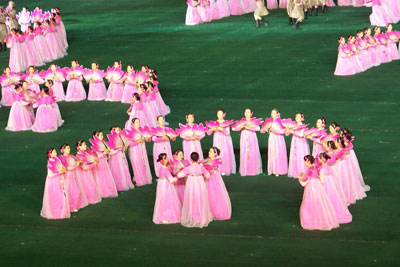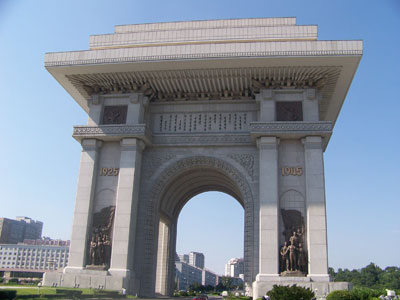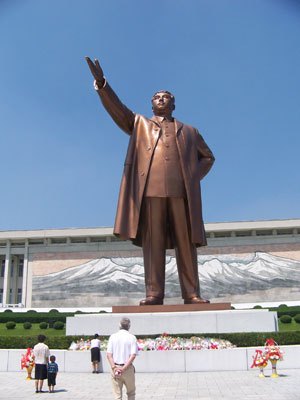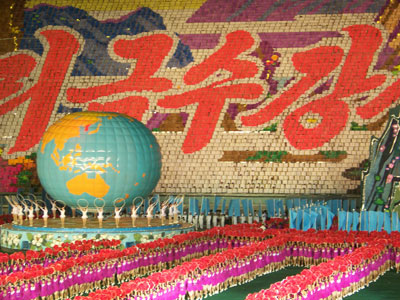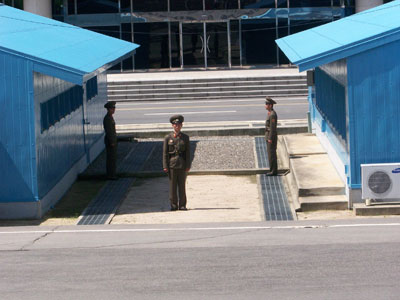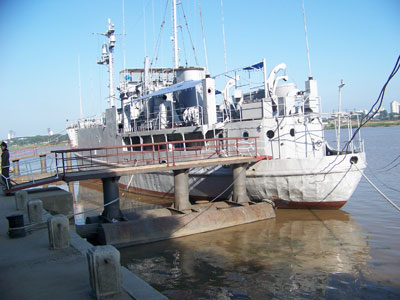The Arirang Mass Games open the door for a visit to North Korea
by Gloria Helmuth, Tulsa, OK
The Democratic People’s Republic of Korea (DPRK), known to the Western world as North Korea, is often in the news even though most of us know very little about that country.
For country collectors, North Korea is another destination to add to a list, but our main purpose in booking a late July ’08 trip was to attend the world-famous Arirang Mass Games, featuring synchronized dance and gymnastic performances. We were not disappointed.
The Games
By good fortune, my husband, Ed, and I happened to be in attendance on the opening night of the Mass Games, which in 2008 was Monday, Aug 4. Our seats were in the front row of the middle tier, near the center — a great spot for seeing the entire show. While our tickets showed we had second-class seats, I did not see any seats better than ours.
Several dignitaries were recognized by the crowd over the loudspeaker, and applause followed; however, Kim Jong Il, the Dear Leader, was not present.
The Games were held at the May Day Stadium, one of the largest in the world, with a capacity of 150,000. The audience was seated on one side, and the young people who would create vibrant backdrops depicting animals, people, birds and scenery using thousands of colored cards were across from us. The highly synchronized card show was performed by approximately 20,000 students.
Also featured were gymnasts and dancers in beautiful costumes — another 30,000 students — who used flags, hoops and other props to create carefully choreographed floor routines. Lighting techniques and a musical background added to the professionalism of the entire program.
I lost track of how many different routines were performed, but the program lasted two hours. The card show began about 8 p.m., with the regular show starting promptly at 8:30.
We were instructed not to take photos while the setup work was being done. The instruction was, “Wait until it is perfect.”
The participants all were young people who worked on this project for months, then performed six nights each week for the 2-month festival. The total number of people involved in putting on this great show was over 100,000.
The Games are held at varying times of the year, usually mid-August until mid-October. This is the best time to visit the country. The second-best time is when a national holiday provides other special performances by young people.
Beyond the Games
Each person’s visit to North Korea is different. The tourism board decides what you should see and when, then advises the government guides where to take you. The resulting itinerary may or may not be what your tour company had been given prior to your arrival.
One of the sites we saw on our tour with Universal Travel Systems was the Demilitarized Zone at Panmunjom, which is almost always included, as the government likes to show Western travelers how the DPRK overcame the “American Imperialists.” Because the DMZ is about 160 kilometers south of Pyongyang, most of one day is needed for a trip there and to the neighboring town of Kaesong, where lunch is available.
In this bleak city we also visited the Kaesong Folklore Hotel, where I purchased a set of nested baskets for $12.
In the countryside nearby, we climbed up a small mountain to visit the Mausoleum of King Tangun, the legendary founder of the first Korean kingdom. The views were good from that spot and worth the short climb.
City sights
In the city of Pyongyang itself, we saw Kim Il Sung Square, aka Fountain Park. At the square are a number of monuments and fountains, but the fountains were not operational when we were there.
The National Library, with the official name of Grand People’s Study House, is on one side of the park. This building claims to be the largest library in the world, with over 30 million books. We were not allowed to go inside.
The Victorious Fatherland Liberation War Museum, a triumphal arch (which we were told is three meters taller than its look-alike in Paris) and a visit to the metro were on our agenda. We were allowed to ride only from one station to the next; no fee was charged.
We also saw the Mansudae Grand Monument, an enormous bronze statue of Kim Il Sung. Flowers are to be laid at his feet by each tour group, to honor the Great Leader.
At the edge of Pyongyang we went to the Mangyongdae Revolutionary Site, where Kim Il Sung was born. This series of simple rustic abodes is furnished with farming utensils and living equipment, or replicas of them, from his early years.
Next we saw the Monument to the Party Founding, or the Worker’s Monument, though it could easily be called the hammer-and-sickle monument. By this point we were getting “monumented out” and I noted how many of these monuments had a similar story: constructed in only a few months and built to recognize one of the Great Leader’s birthdays.
My favorite tour stop wasa middle school where 800 fourteen- to sixteen-year-old students take typical school subjects plus advanced training in musical fields. After seeing their classrooms, we were taken to an auditorium and treated to an excellent musical program.
At the end, Ed and I were invited to participate in some dancing, then we had our photo taken with a few of the performers. These young people were quite talented, and this was truly a highlight of our entire trip.
We were also taken to a variety show where there were aerialists, jugglers, magicians and animal acts. The acrobats were the best.
At the Korea Stamp Store we were able to purchase philatelic sets for collector friends and postcards for our grandchildren, which they received four weeks later.
Our impressions
People from other communist countries are allowed to visit the DPRK anytime of the year; nearby Chinese are the main tourists. Westerners are allowed during specific times, which seem to depend on the relationship with each particular country at the time, but mostly it is only during the Mass Games. Korean International Tourism Services (KITS) operates the tours in the country.
The breakfasts we had were sparse and not self-serve. We were seated, then a plate was brought to us, usually with two hard-fried eggs, two slices of dry white toast, one pat of butter, one small serving of jam and coffee or tea. One day an omelet (with nothing in it) appeared in place of the fried eggs.
We were prepared and had brought along fruit, nuts and snack bars to supplement our meals. Lunches and dinners were more plentiful, with typical Korean foods.
Travel tips
When speaking of the leaders in the country, it is permissible to use either the name or the designation. Kim Il Sung, the Great Leader, died in 1994. The current leader, Kim Jong Il, is referred to as the Dear Leader.
The people are friendly; some even waved. At the school we visited, the children who spoke English were allowed to speak with us. And when we danced with them, they were quite outgoing and warm.
Because the people are not allowed access to the Internet or Western television, they have no way of knowing what the rest of the world is like. We were not allowed to take in DVDs, VHS tapes, etc. — anything that would show them the outside world.
If you visit the DPRK, aim for a good relationship with your “minders,” as they are there for your safety and to act as your guides. Once they have trust in you, something that can be earned by not being critical of them or their country, they will help you.
We were in the country when South Korea issued an order forbidding its citizens from traveling to North Korea because an ROK woman had been killed by a DPRK border guard. Our guides did not discuss any national issues with us.
My husband and I strive to visit UNESCO World Heritage Sites when in a new country. North Korea has only one, the Complex of Goguryeo (or Koguryo) Tombs. After a brief study on the Internet I could not obtain a specific location for the site, so I asked our guides where the tombs were and if we could visit. The guides told me they had never heard of the place.
Small gifts for the guides, something useful like a pen or perhaps some candy, are well received, but, best of all, show your “minder” a sense of humor and an interest in his or her homeland. I found it helpful when the lecture was “anti-American” to mentally plan my grocery list for when we returned home. And I always kept a pleasant expression on my face.
Planning a visit
Because, currently, the only international flight into Pyongyang is a thrice-a-week 2-hour flight from Beijing’s Capital International Airport, we opted to take a tour that included two days in South Korea, two days in Beijing and then four days in Pyongyang.
What every traveler needs to know ahead of time are the rules about taking electronic gear into North Korea. As of 2008, x-ray machines and metal detectors are in operation. All our luggage, checked and carry-on, went through the x-ray machines, then it was also hand searched. After walking through the metal detector, we were wanded and patted down.
Our cell phones were taken away from us and the air-card in our laptop computer removed and stored with our cell phones. We were given our laptop back to use for photo storage and journaling while there. The cell phones and Internet-access air-card were placed in a small cloth bag, for which I was given a receipt, and the items were stored at the airport itself.
As we left the country, one of our guides asked me for the receipt. He retrieved the items, then asked me to verify that they were mine and in good shape. The items had been carefully handled.
Each tour group is attended by at least two government minders. These guides are with you all the time. They meet you in the lobby of the hotel right after your breakfast and leave you at bedtime at the same place.
The government minders provide most of the commentary for your tour. At some venues, a local expert gives you historical information.
Our hotel, Yanggakdo, was located on an island in the Taedong River, and security gates prevented people from leaving the hotel and walking into the city at night. This is not a luxury hotel. It is sparse but sufficient.
A carafe of hot water was placed in our room each day, but we never did decide what we were to do with it, as no coffee or tea bags were available. We opted not to discuss the government or our minders while we were in our hotel room — or anywhere else in the country.
The Yanggakdo Hotel has a small store with a few toiletries for sale, as well as a bookstore and a bar. Be careful about the hotel elevators; we were stranded a couple of times. However, the hotel does have electricity 24 hours a day, which is not standard throughout the city.
Getting there
We had flown from our home in Tulsa to Los Angeles, then took Asiana Airlines into Seoul, South Korea. This first flight on Asiana left us very impressed. The staff was attentive, helpful and very hardworking.
During our 12½-hour westbound flight, we were served two meals and a snack, with water and orange juice brought to us every half hour in between meals.
The restrooms were cleaned at least once an hour and held creamy aftershave, moisturizing hand lotion and packaged toothbrushes and toothpaste. On the return trip, combs in leather cases were set out for us in place of the dental items. We will definitely fly Asiana again.
A visa is required for travel into the DPRK; it can be obtained at the North Korean embassy in Beijing. Allow a full day for this service. I recommend dropping off your passports and a copy of your invitation early in the morning; ask when you can return to pick them up.
If you are with a tour company (recommended), the representative traveling with you should take care of this detail.
North Korean currency can be purchased at your hotel, however we found that it was not needed. Every place we were taken that had anything for sale (rare) accepted US dollars.
For the two of us, the total cost of our trip was $9,800, including our stays in North Korea, South Korea and Beijing and the round-trip airfare from Beijing to Pyongyang. We paid an additional $4,562 in round-trip airfare from Tulsa, Oklahoma. All meals were included.
Our tour guide from Universal Travel Systems (Santa Monica, CA; 800/255-4338, www.uts-travel.com) was Rolf Hildebrand. He is well traveled, and he took good care of us and kept us in good humor.
Rolf was accommodating and handled each new challenge with an easy manner. For instance, when we arrived in Beijing we explained to him that we’d been there before and had seen all the scheduled stops several times, so he completely rewrote the Beijing itinerary to take us to places we had not previously visited.
Looking back
We would definitely like to go back to North Korea. I still want to see the Koguryo Tombs, and we would like to visit the mountainous northern part of the country, near the Chinese border. KITS will take a tour group to that part of the country only when they have enough people to fill a plane. In the past few years there have not been enough Westerners traveling to North Korea to offer the mountain side-trip option.
I will be glad to answer specific questions about our trip to the DPRK or about traveling with UTS. E-mail us c/o ITN.


